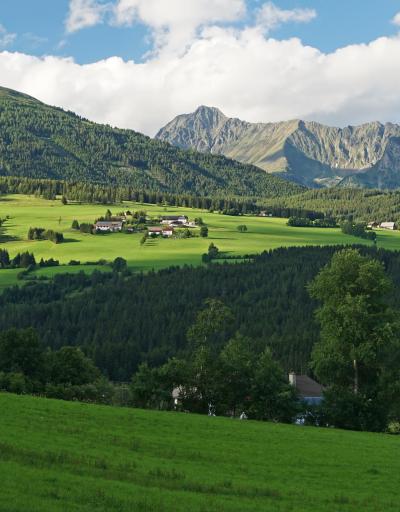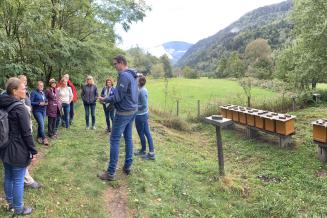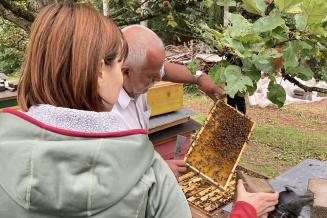It offered an opportunity to meet in person to discuss the latest progress on collective approaches to managing interactions between people and nature to support biodiversity conservation and to test innovative solutions for sustainable development in biosphere reserves. Participants included biosphere reserve managers, scientists, practitioners, businesses and youth.
A workshop on ecological beekeeping
The conference was a hive of activity – in more ways than one. One of the workshops offered an opportunity for women beekeepers from different biosphere reserves to exchange knowledge and know-how and visit apiaries from beekeepers of the Carinthian Beekeepers Association, which counts more than 3 400 beekeepers. The women were part of the UNESCO–Guerlain Women for Bees programme, which organized the workshop.
This programme is important because bees, along with other pollinators such as bats, butterflies and hummingbirds, not only contribute to human food security but also play a vital role in conserving biodiversity. Nearly 90% of the world’s wild flowering plant species depend on animal pollination, along with more than three-quarters of the world’s food crops[1]. It is estimated that more than 40% of bee species may be threatened with extinction[2].
During the outdoor workshop, there were presentations by five women from the Women for Bees programme in the Central Balkan Biosphere Reserve (Bulgaria), Moselle Sud Biosphere Reserve (France) and Kozjansko & Obsotelje Biosphere Reserve (Slovenia).
Slovenia has over 500 species of wild bee[3], including 35 species of bumblebee. In the Kosjansko and Obsotelje Biosphere Reserve, the UNESCO–Guerlain Women for Bees programme is contributing to the conservation of the native Carniolan bee (Apis mellifera carnica), a subspecies of the Western honeybee that is very gentle to manage. The programme is training women beekeepers how to make their apiaries ecological to conserve local breeds.
During the workshop, discussions focused on how to encourage individual and collective good practices in urban and rural areas, as well as the importance of different ecotypes of bee and their conservation, particularly in light of climate change.
Other thematic workshops also explored ways of reconciliating humans with nature in the EuroMAB region, which counts 308 UNESCO biosphere reserves in 41 countries across Europe and North America.
A particular emphasis was laid on intergenerational dialogue, including through a full-day preparatory meeting with youth to share updates of their activities within the EuroMAB Youth Network. Two workshops were also organized for this age group, one on the theme of building the biosphere reserves of the future and another on how youth could contribute to the EuroMAB Network’s next action plan.
As a result of youth’s participation in the conference, a decision was taken to include young people as part of the EuroMAB Steering Committee alongside its new members.
Biosphere reserves confronting historically low river levels
The conference was organized under the theme “Tying cultures. Crossborder cooperation between societies and generations” by the Austrian Man and the Biosphere (MAB) Committee and hosted by the Salzburger Lungau and Kärntner Nockberge Biosphere Reserve. Attended by over 150 people, it was an environmentally friendly and resource-saving event, with a focus on cultural links and cross-border cooperation.
Austria is one of five countries which share the Mura–Drava–Danube Transboundary Biosphere Reserve, established in 2021. Covering almost one million square kilometres, it spans Austria, Croatia, Hungary, Serbia and Slovenia.
This year, Europe has experienced its hottest and driest summer on record. The exceptional drought and high temperatures have caused water levels in European rivers to drop to historic lows. This has threatened the Danube River’s role as an important transport route and perturbed not only wildlife but also trade, local businesses like restaurants and energy generation.
To conserve the ecosystems along the length of the Danube River and support the populations that depend upon them will take concerted action, which is why the creation of the Mura–Drava–Danube Transboundary Biosphere Reserve has been such an important step for transboundary cooperation.
Marianne Penker, Chair of the Austrian MAB Committee, recalled at the EuroMAB conference that the Man and Biosphere programme ‘strives to breach borders across disciplines and sectors, nature and development, science and society to provide solutions to the biodiversity and climate challenges ahead’.
Wildfires have ravaged many European biosphere reserves
Many European biosphere reserves have reported wildfires this summer. Spain, which counts the most biosphere reserves in Europe (53), including three transboundary ones with Portugal and a fourth with Morocco, has been no exception.
Some 15 Spanish biosphere reserves have experienced wildfires, according to data from Copernicus – Emergency Management Services, a project of the European Union. A preliminary analysis conducted by the Spanish MAB Committee using data from NASA-VIIRS Active fires revealed that approximately 40 000 hectares had burned in Spanish biosphere reserves between 23 June and 24 August 2022.
The greatest damage was recorded in the Meseta Ibérica Transboundary Biosphere Reserve shared with Portugal, where as much as 20 000 hectares burned.
In the Gerês-Xurés Transboundary Biosphere Reserve, also shared with Portugal, a group of scientists have elaborated a scenario for how farmland protection and fire-smart management could help prevent wildfires in the coming decade, while enhancing biodiversity and carbon sequestration in biomass[4]. Fire-smart management would include restoring coniferous plantations to native oak woodlands to limit the spread of fire, as oak trees have a very thick bark that is heat-resistant. The scientists who prepared the analysis estimate that supporting farmlands to prevent and reverse rural abandonment could help reduce the extent of areas affected by large-scale fires by as much as by 50% over 2030–2050.
The commitment and outcomes from biosphere reserves in the EuroMAB Network show that they are already investing in a better future, based on the evidence that it is still possible not only to be reconciled with each other but also with living beings everywhere on Earth.












